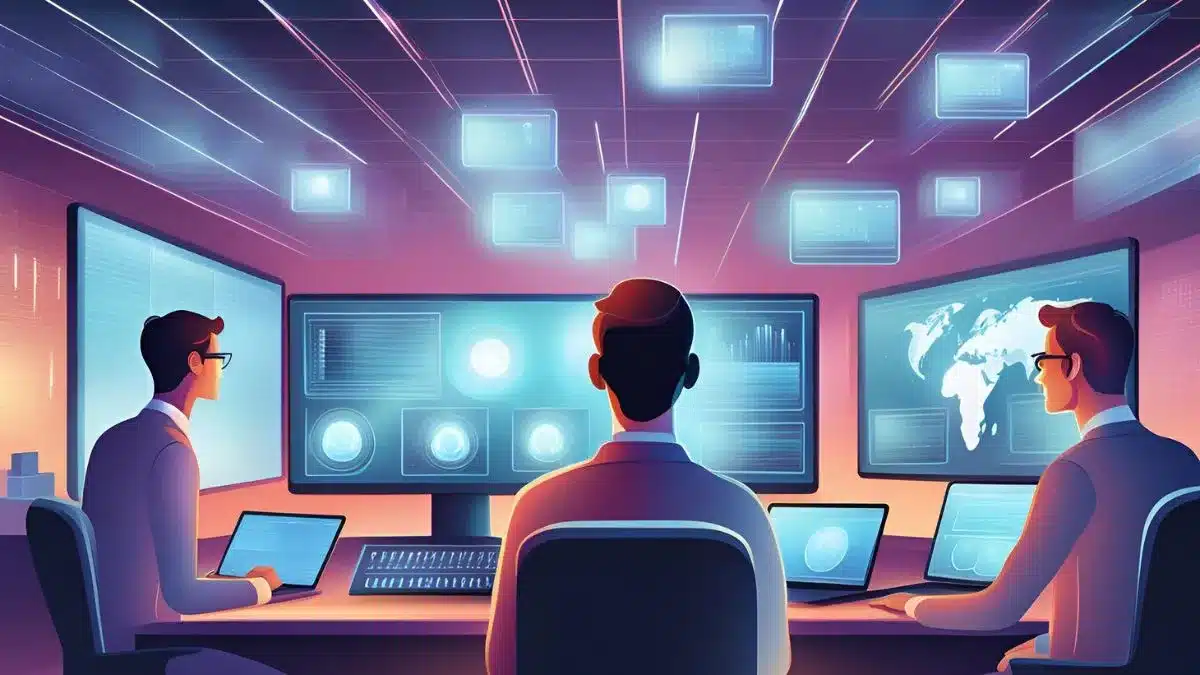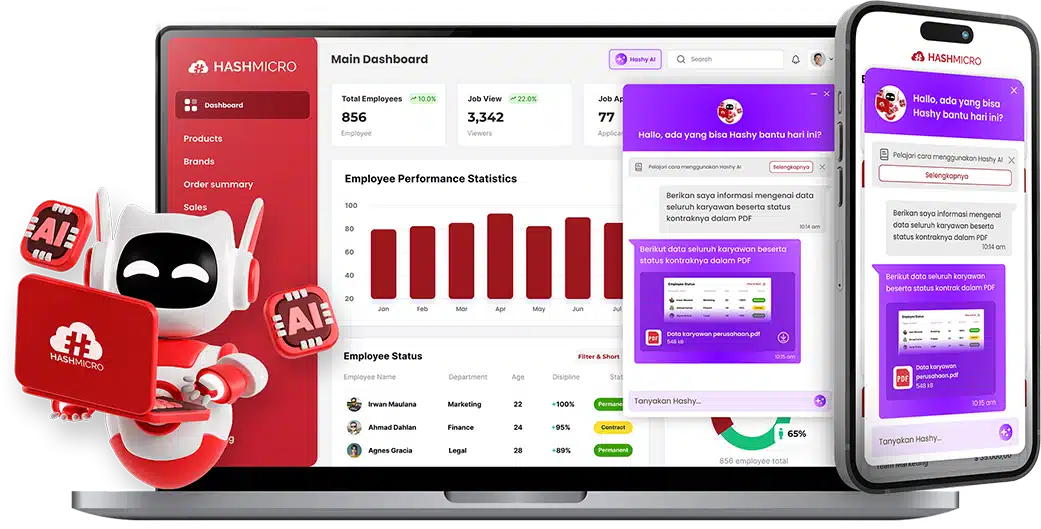AI in HR is no longer a futuristic concept; it’s a game-changer in HR today. In fact, 76% of HR leaders believe that organizations refusing to adopt AI within the next two years will fall behind their competitors.
Yet, despite its clear benefits, 37% of HR leaders still struggle with AI adoption due to integration issues with existing systems. It’s also interesting to note that the gap between AI-driven and traditional HR is growing.
Companies using artificial intelligence tend to work smarter, while those that don’t face inefficiency, talent loss, and rising admin burdens. The question isn’t whether AI belongs in HR—but how fast companies can implement it to stay competitive.
So, how exactly can AI transform HR? And what steps should businesses take to overcome integration challenges? This article will uncover the answers. Read on to find out!
Key Takeaways
|
Table of Contents
What is AI in HR?
AI in HR means using smart technologies like machine learning (ML), predictive analytics, and natural language processing (NLP) to help automate tasks that usually require human effort.HR teams use it to make hiring, payroll, and benefits management more efficient.
It can also help create policy documents, draft contracts, and provide instant support to employees.
AI enables data-driven decisions for employee training, retention, and workforce planning while reducing bias and improving the overall experience for employees and job candidates. It can be used at different levels in a company, each with its own benefits and risks.
For individuals, AI helps save time and improve work quality with little risk. On a company-wide scale, AI supports big business decisions, but the impact and risks are much higher.
Hashy AI Fact

Need to know!
Hashy AI from HashMicro simplifies your business operation with smart automation, eliminating time-consuming manual tasks and ensuring more accurate and efficient processes.
Get a Free Demo Now!
Types of AI in HR
AI in HR is powered by various technologies, each designed for specific tasks. While AI is often discussed as a single tool, it consists of multiple specialized technologies that enhance different HR functions.
1. Generative AI
Generative AI analyzes patterns in training data to create new content, including text, images, media, and programming code.
- Writes job descriptions, employee performance goals, and interview questions.
- Updates and revises content to align with changing policies.
2. Conversational AI
Conversational AI simulates human conversations using technologies like chatbots and virtual agents powered by natural language processing (NLP).
- Allows employees to update personal data and access job-related information.
- Enables employees to give or request job-related feedback.
- Provides instant answers to HR questions using AI-powered chatbots that gather and summarize information.
3. Deep Learning
Deep learning analyzes HR data to generate detailed insights and recommendations.
- Creates personalized recommendations for employee learning, career paths, project assignments, team collaborations, mentorships, and peer connections.
4. Automation
AI-driven automation executes simulations and streamlines HR decision-making.
- Suggests the best benefits packages for individual employees.
- Detects fraud in payroll processing.
Applications of AI in HR
AI can improve various HR processes, from hiring and training to increasing employee engagement and retention. Below are some ways HR teams can use AI to improve recruitment.
1. Recruitment Process Improvements
AI can enhance nearly every step of hiring, helping companies find the right candidates while significantly reducing the time required to fill positions.
- Use a standardized skills framework to attract, source, and hire talent globally through AI workflow automation to automate processes, personalized communication, and integrated workflows.
- Assist recruiters and hiring managers with recruiting tools that automate repetitive tasks, such as creating unbiased interview questions and job descriptions suited to specific roles.
- Administer skills and aptitude assessments to rank candidates based on their job suitability.
- Provide objective interview feedback by analyzing applicant responses without bias.
- Use chatbots to communicate with candidates around the clock, answering questions and keeping them engaged throughout the recruitment process.
- Identify hidden talent by analyzing external data sources like job boards, social media, and professional networks to infer candidates’ skills and invite them to apply.
2. Improving Onboarding
Once candidates are hired, AI can simplify the onboarding process, especially for remote and contract workers who may not have access to in-person training.
- Offer 24/7 onboarding support using AI chatbots, reducing the need for HR staff to handle calls, emails, and meetings.
- Personalize the onboarding experience to make new employees feel engaged and welcomed.
- Automate document distribution by ensuring new hires receive contracts, company policies, login credentials, and job-specific permissions without manual intervention.
3. Adjusting Talent Management
Managing employee growth and aligning it with business goals is challenging, especially for large organizations. Artificial intelligence helps HR teams understand employees’ skills and career aspirations, making talent management more effective.
- Skills Mapping – Create a detailed skills framework that identifies employees’ abilities, matches them to job roles, and highlights areas for improvement.
- Accurate Skills Assessment – Use AI to evaluate complex human skills like creativity and emotional intelligence more objectively.
- Personalized Career Development – Recommend tailored learning programs, mentorships, assignments, and career paths based on an employee’s interests and skills.
- Upskilling and Reskilling – Suggest training programs that help employees gain new skills and prepare for future roles.
- Internal Talent Mobility – Identify employees with transferable skills and suggest new roles or projects to help them advance within the company.
- Real-Time Performance Insights – Provide continuous, data-driven feedback to managers and employees to support ongoing improvement.
- Strategic Workforce Planning – Use AI-driven predictions to help HR plan for future hiring needs and skill gaps.
4. Improves Employee Experience
Keeping employees engaged and motivated is essential for retaining top talent. AI can help HR create a better work environment by making daily interactions more efficient and personalized.
- Personalized Support – AI customizes support and resources based on an employee’s needs, work habits, and preferences.
- Faster Access to Information – AI-powered tools, like digital assistants and copilots, help employees quickly find information, complete tasks, and resolve issues.
- Proactive Well-Being Support – IoT sensors and AI analytics can track stress levels, emotional well-being, and workload patterns.
- Instant Feedback and Guidance – AI enables real-time feedback systems that provide employees with continuous coaching and support.
- Self-Service for HR Tasks – Employees can access and update HR-related information, such as personal details, payroll, time tracking, and recognition programs.
- Smarter HR Assistance – Generative AI can process company policies and provide clear answers to HR-related questions.
Benefits of Using AI in HR
 As technology advances, AI in ERP is stepping in to handle time-consuming processes at every level of HR tasks. Below are some of the benefits the companies will reap by using AI:
As technology advances, AI in ERP is stepping in to handle time-consuming processes at every level of HR tasks. Below are some of the benefits the companies will reap by using AI:
- HR processes move faster than ever. Recruitment, onboarding, and performance reviews no longer require hours of manual work, and better yet, no mo.
- Productivity reaches new heights. Low-value, repetitive work no longer drains resources. AI handles administrative tasks in seconds, keeping HR teams efficient and focused.
- Bias gets removed from the equation. AI scans job descriptions, interview questions, and performance evaluations to eliminate language that could introduce unconscious bias. Hiring decisions become fairer and more inclusive.
- Employee and candidate experiences feel more personal. AI-driven interactions adjust to individual needs, making hiring, onboarding, and support more engaging and responsive.
- Data becomes easier to understand. Generative AI analyzes complex information in seconds, summarizes key findings, and presents actionable insights without the need for manual reports.
- Decision-making shifts from guesswork to strategy. HR leaders gain access to deeper insights, helping them manage workforce planning, salary benchmarks, and performance trends with confidence.
- HR and business operations connect seamlessly. AI integrates with multiple systems, linking HR data with financial, operational, and performance metrics to support high-level business decisions.
- Workforce planning moves from reactive to proactive. AI analyzes skill gaps, forecasts talent needs, and helps businesses stay ahead of market changes before they become problems.
With AI in place, HR teams step into a more strategic role—not just managing employees, but shaping the future of work itself.
Challenges of Using AI in HR
HR teams and employees welcome AI for skill development, career growth, and self-service tools, but hesitate when it comes to handling sensitive data, performance evaluations, or monitoring.
Here are the breakdowns of the challenges in using AI-enabled HR system, since the emergence of a new technology always come with a set of new setbacks:
1. Bias in AI Systems
AI can reinforce bias if not managed properly. To prevent this, companies should choose HR AI tools that prioritize transparency, fairness, and explainable decision-making.
For example, in recruitment, responsible AI automatically detects and removes biased language from job descriptions, ensuring hiring criteria are based on skills rather than subjective wording.
2. Data Accuracy, Privacy, and Security
AI models are only as good as the data they process—flawed or incomplete data leads to unreliable results.
Privacy and security are also major concerns. AI-driven HR tools handle sensitive employee data, yet some mainstream AI systems have already experienced data breaches due to security flaws.
To avoid risks, businesses should work with HR AI providers that keep company data private and do not share it with external AI models.
3. Losing the Human Touch
HR is about people, and relying too much on AI can make interactions feel cold and impersonal. Employees may feel disconnected, especially in situations that require empathy and human judgment rather than data-driven decisions.
Overuse of AI also poses legal risks. Some regulations restrict the use of AI in hiring, promotions, or salary decisions.
While AI can assist with writing job descriptions, it shouldn’t replace human involvement in interviews or performance evaluations, where emotional intelligence is essential.
4. Job Security Concerns in HR
According to a Jobstreet study, 35% of Filipino workers fear significant transformations or job loss, as the adoption of AI increases.
HR teams can ease these concerns by clarifying which tasks AI will handle—routine administrative work can be automated, but strategic decision-making and people-focused tasks will always require human expertise.
Strategies of Using AI for HR
To get the most out of AI, HR leaders must carefully plan how to use it. AI offers huge benefits, but without proper planning, it can lead to bias, errors, or employee resistance. Here’s a simple roadmap to avoid these pitfalls:
1. Overcome Key Challenges
Before rolling out AI, HR leaders must address potential risks. For example, accuracy, fairness, and transparency might become issues if not handled carefully. To tackle these challenges:
- Assign AI Specialists: Create dedicated HR roles to manage AI implementation to keep tools aligned with company goals, and collaborate with IT and legal teams.
- Prioritize Key Areas: Choose specific tasks that clearly benefit from AI, such as administrative tasks or employee support services.
- Train Employees: Invest in developing AI-related skills within your team so employees feel supported rather than replaced.
2. Determine Steps to Successfully Implement AI
After addressing initial challenges, HR leaders can move forward with a clear plan. First, carefully evaluate existing AI use and determine specific objectives for your HR function.
Next, implement AI smoothly with these actions:
- Collaborate Across Teams: Partner with departments such as IT and operations to align AI usage with broader company strategies.
- Educate Your HR Team: Offer training sessions and workshops so employees feel confident using GenAI.
- Focus on High-Impact Tasks:
- Employee Chatbots: Automate routine employee support to speed up service.
- Administrative Automation: Cut down paperwork and repetitive reporting tasks.
- Recruitment Optimization: Improve job descriptions, automate resume checks, and identify candidates more quickly.
3. Regularly Monitor and Adjust AI Usage
Even after implementation, AI requires continuous assessment. Regular monitoring allows HR to track success in recruitment, workflow improvements, and employee satisfaction.
Consider these points when reviewing your progress:
- Measure Results: Regularly assess how AI is impacting daily HR processes and overall productivity.
- Stay Flexible: Be ready to adjust AI tools and strategies based on ongoing results and employee feedback.
With careful planning and ongoing adjustments, HR leaders can turn AI into a reliable tool that helps employees work smarter and keeps the entire team moving forward.
Simplify HR Administration with Hashy AI
 AI in HR won’t replace humans. Rather, it just makes administration much simpler, so that HR teams can focus on doing more impactful things, like recruiting the best talent, mediating internal problems, and implementing the right training to the right employees.
AI in HR won’t replace humans. Rather, it just makes administration much simpler, so that HR teams can focus on doing more impactful things, like recruiting the best talent, mediating internal problems, and implementing the right training to the right employees.
The result? Employees are happier, turnover decreases drastically, productivity increases, and profits also increase. Everybody is happy.
Enter Hashy AI: a smart virtual AI assistant who is ready to help with HR matters from staff to manager level. In essence, from regular employees to managerial level, your work life will be much easier with Hashy!
So, what does Hashy AI offer, and is it really helpful for every party in the company? Absolutely. Let’s take a look at its capabilities:
For Employees:
- Leave Applications: Request leave and instantly check application status without filling out paperwork.
- Attendance & Overtime Tracking: Quickly update attendance and overtime hours directly from your phone.
- Travel & Expense Management: Submit travel requests and expense claims easily through chat—no hassle involved.
- Instant SOP Support: Have questions? Get quick, accurate answers about HR policies and procedures anytime.
For Managers:
- One-Click Approvals: Approve leave, overtime, expenses, or travel requests instantly without paperwork.
- Automated Reporting: Generate leave, attendance, overtime, and expense reports effortlessly, without manual data crunching.
- Real-Time Insights: Instantly access data to quickly spot trends and make strategic decisions.
Aside from that, Hashy is accessible anytime and anywhere, including desktop, Android, and iOS. Convenient, right? It doesn’t matter whether you have urgent matters or want to know the reports on attendances or expenses, Hashy AI can do it all.
Conclusion
AI in HR isn’t just about automation. It’s also about making work smoother, decisions smarter, and businesses stronger. With AI handling repetitive tasks, HR teams can focus on what truly matters: hiring the right people, nurturing talent, and building a thriving workplace.
Hashy AI takes things even further, acting as your 24/7 HR assistant that simplifies processes and speeds up approvals. Need to request leave, track attendance, or manage expenses? Hashy makes everything instant, effortless, and accessible anytime, anywhere.
Why waste time on paperwork when AI can do it for you? With Hashy, HR teams stay productive, employees stay happy, and businesses keep growing. Work smarter, not harder— and let Hashy AI handle the rest.
Interested yet? Try the free demo now!

Frequently Asked Questions on AI in HR
-
How does intelligent automation impact employee well-being in the workplace?
Smart systems can support or undermine employee well-being, depending on how they are introduced and perceived. While they improve efficiency and reduce bias, concerns about job security, fairness, and privacy may arise
-
What are the ethical considerations of using machine intelligence in hiring?
Algorithm-driven hiring raises concerns about bias, fairness, and transparency. If not properly managed, these systems can reinforce existing biases present in data. Ensuring fairness requires explainable decision-making and accountability in automated hiring processes
-
What challenges do organizations face when integrating automated decision-making into HR?
Businesses may struggle with data security, employee upskilling, and resistance to change when implementing intelligent systems. Overcoming these issues requires clear communication, ongoing training, and involving employees in the transition process.
-
How can cognitive computing assist in employee onboarding?
Advanced technology simplifies onboarding by automating administrative tasks, offering instant chatbot support, and tailoring the process to each new hire.




































